Piezo 1 and Piezo 2 in the Chemosensory Organs of Zebrafish (Danio rerio)
Abstract
:1. Introduction
2. Results
2.1. Anti-Piezo 1, Piezo 2, and Calretinin Specificity in Zebrafish
2.1.1. Alignment of Antibody Immunogen Sequences with the Respective Zebrafish Proteins
2.1.2. Western Blot Analyses
2.2. Piezo 1, Piezo 2, and Calretinin Expression Patterns in Zebrafish Chemosensory Organs
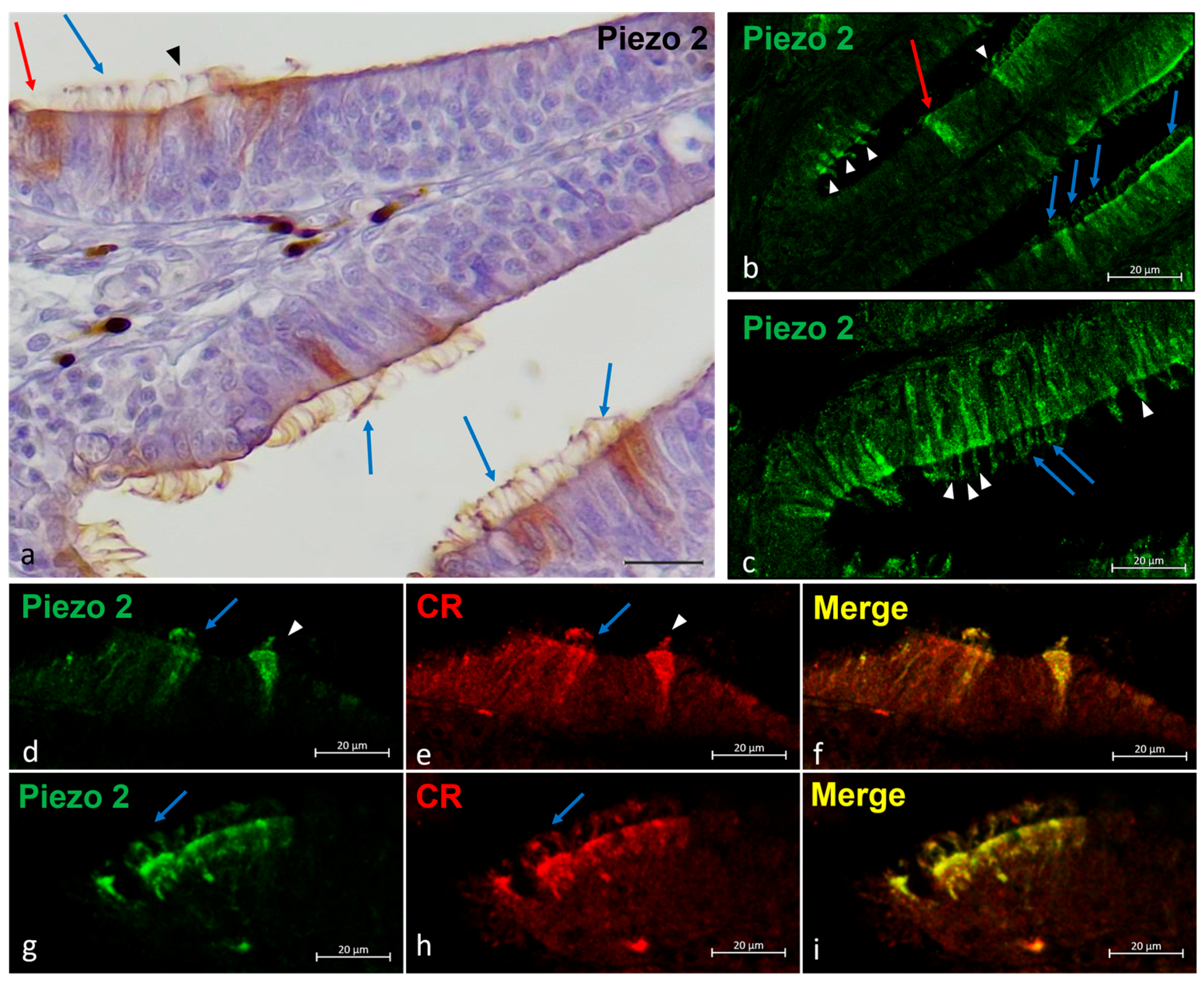
2.3. Statistical Analysis
3. Discussion
4. Materials and Methods
4.1. Piezo 1, Piezo 2, and Calretinin Specificity in Zebrafish
4.1.1. Blast of the Antibody Immunogen Sequences with the Respective Zebrafish Proteins
4.1.2. Western Blot Analyses
4.2. Sample Treatment
4.3. Immunohistochemistry
4.3.1. Peroxidase Method
| Primary Antibodies | Supplier | Catalogue Number | Source | Dilution | Antibody ID |
|---|---|---|---|---|---|
| Piezo 1 | Invitrogen-Thermo Fisher Scientific, Waltham, MA USA | PA5-106296 | rabbit | 1:100 | AB_2853973 |
| Piezo 2 | Invitrogen-Thermo Fisher Scientific, Waltham, MA USA | PA5-72975 | rabbit | 1:100 | AB_2718829 |
| Calretinin | Santa Cruz Biotechnology, Inc., Dallas, Texas, USA | sc-11644 | goat | 1:100 | AB_634545 |
| Secondary Antibodies | Supplier | Catalogue Number | Source | Dilution | Antibody ID |
| anti-Goat IgG (H + L) Alexa Fluor 594 | Invitrogen-Thermo Fisher Scientific, Waltham, MA USA | A-11058 | donkey | 1:300 | AB_2534102 |
| anti-Rabbit IgG (H + L) Alexa Fluor 488 | Invitrogen-Thermo Fisher Scientific, Waltham, MA USA | A-11008 | goat | 1:300 | AB_143165 |
| anti-rabbit IgG-peroxidase conjugate | Amersham bioscences, Piscataway, NJ, USA | NA934 | donkey | 1:100 | AB_772206 |
4.3.2. Confocal Immunofluorescence
4.3.3. Cell Counting
4.4. Statistical Analysis
5. Conclusions
Author Contributions
Funding
Institutional Review Board Statement
Informed Consent Statement
Data Availability Statement
Conflicts of Interest
References
- Hansen, A.; Eckart, Z. The peripheral olfactory organ of the zebrafish, Danio rerio: An ultrastructural study. Chem. Senses 1998, 23, 39–48. [Google Scholar] [CrossRef] [PubMed]
- Hansen, A.; Reutter, K.; Zeiske, E. Taste bud development in the zebrafish, Danio rerio. Dev. Dyn. 2002, 223, 483–496. [Google Scholar] [CrossRef] [PubMed]
- Korsching, S.I.; Argo, S.; Campenhausen, H.; Friedrich, R.W.; Rummrich, A.; Weth, F. Olfaction in zebrafish: What does a tiny teleost tell us? Semin. Cell Dev. Biol. 1997, 8, 181–187. [Google Scholar] [CrossRef] [PubMed]
- Whitfield, T.T. Zebrafish as a model for hearing and deafness. J. Neurobiol. 2002, 53, 157–171. [Google Scholar] [CrossRef] [PubMed]
- Bhattarai, P.; Cosacak, M.I.; Mashkaryan, V.; Demir, S.; Popova, S.D.; Govindarajan, N.; Brandt, K.; Zhang, Y.; Chang, W.; Ampatzis, K. Neuron-glia interaction through Serotonin-BDNF-NGFR axis enables regenerative neurogenesis in Alzheimer’s model of adult zebrafish brain. PLoS Biol. 2020, 18, e3000585. [Google Scholar] [CrossRef] [PubMed]
- Kumar, V.; Singh, C.; Singh, A. Zebrafish an experimental model of Huntington’s disease: Molecular aspects, therapeutic targets and current challenges. Mol. Biol. Rep. 2021, 48, 8181–8194. [Google Scholar] [CrossRef]
- Cacialli, P. Neurotrophins Time Point Intervention after Traumatic Brain Injury: From Zebrafish to Human. Int. J. Mol. Sci. 2021, 22, 1585. [Google Scholar] [CrossRef]
- Lucini, C.; D’Angelo, L.; Cacialli, P.; Palladino, A.; De Girolamo, P. BDNF, Brain, and Regeneration: Insights from Zebrafish. Int. J. Mol. Sci. 2018, 19, 3155. [Google Scholar] [CrossRef]
- Aragona, M.; Porcino, C.; Guerrera, M.C.; Montalbano, G.; Laurà, R.; Cometa, M.; Levanti, M.; Abbate, F.; Cobo, T.; Capitelli, G.; et al. The BDNF/TrkB Neurotrophin System in the Sensory Organs of Zebrafish. Int. J. Mol. Sci. 2022, 23, 2621. [Google Scholar] [CrossRef]
- Aragona, M.; Porcino, C.; Guerrera, M.C.; Montalbano, G.; Laurà, R.; Levanti, M.; Abbate, F.; Cobo, T.; Capitelli, G.; Calapai, F.; et al. Localization of BDNF and Calretinin in Olfactory Epithelium and Taste Buds of Zebrafish (Danio rerio). Int. J. Mol. Sci. 2022, 23, 4696. [Google Scholar] [CrossRef]
- Ching, K.; Wang, J.T.; Stearns, T. Long-range migration of centrioles to the apical surface of the olfactory epithelium. eLife 2022, 11, e74399. [Google Scholar] [CrossRef] [PubMed]
- Abbate, F.; Guerrera, M.C.; Montalbano, G.; Ciriaco, E.; Germanà, A. Morphology of the tongue dorsal surface of gilthead seabream (Sparus aurata). Microsc. Res. Tech. 2012, 75, 1666–1671. [Google Scholar] [CrossRef] [PubMed]
- Abbate, F.; Guerrera, M.C.; Montalbano, G.; De Carlos, F.; Suárez, A.Á.; Ciriaco, E.; Germanà, A. Morphology of the european sea bass (Dicentrarchus labrax) tongue. Microsc. Res. Tech. 2012, 75, 643–649. [Google Scholar] [CrossRef] [PubMed]
- Montalbano, G.; Levanti, M.; Mhalhel, K.; Abbate, F.; Laurà, R.; Guerrera, M.C.; Aragona, M.; Germanà, A. Acid-Sensing Ion Channels in Zebrafish. Animals 2021, 11, 2471. [Google Scholar] [CrossRef] [PubMed]
- Levanti, M.; Randazzo, B.; Viña, E.; Montalbano, G.; Garcia-Suarez, O.; Germanà, A.; Vega, J.; Abbate, F. Acid-sensing ion channels and transient-receptor potential ion channels in zebrafish taste buds. Ann. Anat. Anat. Anz. 2016, 207, 32–37. [Google Scholar] [CrossRef] [PubMed]
- Gu, Y.; Gu, C. Physiological and pathological functions of mechanosensitive ion channels. Mol. Neurobiol. 2014, 50, 339–347. [Google Scholar] [CrossRef] [PubMed]
- Lamandé, S.R.; Yuan, Y.; Gresshoff, I.L.; Rowley, L.; Belluoccio, D.; Kaluarachchi, K.; Little, C.B.; Botzenhart, E.; Zerres, K.; Amor, D.J.; et al. Mutations in TRPV4 cause an inherited arthropathy of hands and feet. Nat. Genet. 2011, 43, 1142–1146. [Google Scholar] [CrossRef] [PubMed]
- Coste, B.; Mathur, J.; Schmidt, M.; Earley, T.J.; Ranade, S.; Petrus, M.J.; Dubin, A.E.; Patapoutian, A. Piezo1 and Piezo2 Are Essential Components of Distinct Mechanically Activated Cation Channels. Science 2010, 330, 55–60. [Google Scholar] [CrossRef] [PubMed]
- Fang, X.-Z.; Zhou, T.; Xu, J.-Q.; Wang, Y.-X.; Sun, M.-M.; He, Y.-J.; Pan, S.-W.; Xiong, W.; Peng, Z.-K.; Gao, X.-H.; et al. Structure, kinetic properties and biological function of mechanosensitive Piezo channels. Cell Biosci. 2021, 11, 13. [Google Scholar] [CrossRef]
- Schneider, E.R.; Mastrotto, M.; Laursen, W.J.; Schulz, V.P.; Goodman, J.B.; Funk, O.H.; Gallagher, P.G.; Gracheva, E.O.; Bagriantsev, S.N. Neuronal mechanism for acute mechanosensitivity in tactile-foraging waterfowl. Proc. Natl. Acad. Sci. USA 2014, 111, 14941–14946. [Google Scholar] [CrossRef]
- Faucherre, A.; Kissa, K.; Nargeot, J.; Mangoni, M.E.; Jopling, C. Piezo1 plays a role in erythrocyte volume homeostasis. Haematologica 2014, 99, 70–75. [Google Scholar] [CrossRef]
- Cobo, R.; García-Piqueras, J.; García-Mesa, Y.; Feito, J.; García-Suárez, O.; Vega, J.A. Peripheral Mechanobiology of Touch—Studies on Vertebrate Cutaneous Sensory Corpuscles. Int. J. Mol. Sci. 2020, 21, 6221. [Google Scholar] [CrossRef] [PubMed]
- Liu, T.-T.; Du, X.-F.; Zhang, B.-B.; Zi, H.-X.; Yan, Y.; Yin, J.-A.; Hou, H.; Gu, S.-Y.; Chen, Q.; Du, J.-l. Piezo1-Mediated Ca2+ Activities Regulate Brain Vascular Pathfinding during Development. Neuron 2020, 108, 180–192.e185. [Google Scholar] [CrossRef] [PubMed]
- Moroni, M.; Servin-Vences, M.R.; Fleischer, R.; Sánchez-Carranza, O.; Lewin, G.R. Voltage gating of mechanosensitive PIEZO channels. Nat. Commun. 2018, 9, 1096. [Google Scholar] [CrossRef]
- Lechner, S.G.; Lewin, G.R. Peripheral sensitisation of nociceptors via G-proteindependent potentiation of mechanotransduction currents. J. Physiol. 2009, 587, 3493–3503. [Google Scholar] [CrossRef] [PubMed]
- Lewin, G.R.; Lechner, S.G.; Smith, E.S.J. Nerve Growth Factor and Nociception: From Experimental Embryology to New Analgesic Therapy. In Neurotrophic Factors; Lewin, G.R., Carter, B.D., Eds.; Springer: Berlin/Heidelberg, Germany, 2014; pp. 251–282. [Google Scholar] [CrossRef]
- Dubin, A.E.; Schmidt, M.; Mathur, J.; Petrus, M.J.; Xiao, B.; Coste, B.; Patapoutian, A. Inflammatory Signals Enhance Piezo2-Mediated Mechanosensitive Currents. Cell Rep. 2012, 2, 511–517. [Google Scholar] [CrossRef] [PubMed]
- Phillips, R.; Ursell, T.; Wiggins, P.; Sens, P. Emerging roles for lipids in shaping membrane-protein function. Nature 2009, 459, 379–385. [Google Scholar] [CrossRef]
- Janmey, P.A.; Kinnunen, P.K.J. Biophysical properties of lipids and dynamic membranes. Trends Cell Biol. 2006, 16, 538–546. [Google Scholar] [CrossRef] [PubMed]
- Wu, Z.; Grillet, N.; Zhao, B.; Cunningham, C.; Harkins-Perry, S.; Coste, B.; Ranade, S.; Zebarjadi, N.; Beurg, M.; Fettiplace, R.; et al. Mechanosensory hair cells express two molecularly distinct mechanotransduction channels. Nat. Neurosci. 2017, 20, 24–33. [Google Scholar] [CrossRef]
- Kim, S.E.; Coste, B.; Chadha, A.; Cook, B.; Patapoutian, A. The role of Drosophila Piezo in mechanical nociception. Nature 2012, 483, 209–212. [Google Scholar] [CrossRef]
- Coste, B.; Xiao, B.; Santos, J.S.; Syeda, R.; Grandl, J.; Spencer, K.S.; Kim, S.E.; Schmidt, M.; Mathur, J.; Dubin, A.E.; et al. Piezo proteins are pore-forming subunits of mechanically activated channels. Nature 2012, 483, 176–181. [Google Scholar] [CrossRef]
- Kamajaya, A.; Kaiser, J.T.; Lee, J.; Reid, M.; Rees, D.C. The Structure of a Conserved Piezo Channel Domain Reveals a Topologically Distinct β Sandwich Fold. Structure 2014, 22, 1520–1527. [Google Scholar] [CrossRef] [PubMed]
- Prole, D.L.; Taylor, C.W. Identification and analysis of putative homologues of mechanosensitive channels in pathogenic protozoa. PLoS ONE 2013, 8, e66068. [Google Scholar] [CrossRef]
- Faucherre, A.; Nargeot, J.; Mangoni, M.E.; Jopling, C. piezo2b Regulates Vertebrate Light Touch Response. J. Neurosci. 2013, 33, 17089. [Google Scholar] [CrossRef]
- Faucherre, A.; Moha ou Maati, H.; Nasr, N.; Pinard, A.; Theron, A.; Odelin, G.; Desvignes, J.-P.; Salgado, D.; Collod-Béroud, G.; Avierinos, J.-F.; et al. Piezo1 is required for outflow tract and aortic valve development. J. Mol. Cell. Cardiol. 2020, 143, 51–62. [Google Scholar] [CrossRef]
- Eisenhoffer, G.T.; Loftus, P.D.; Yoshigi, M.; Otsuna, H.; Chien, C.-B.; Morcos, P.A.; Rosenblatt, J. Crowding induces live cell extrusion to maintain homeostatic cell numbers in epithelia. Nature 2012, 484, 546–549. [Google Scholar] [CrossRef] [PubMed]
- Song, Y.; Li, D.; Farrelly, O.; Miles, L.; Li, F.; Kim, S.E.; Lo, T.Y.; Wang, F.; Li, T.; Thompson-Peer, K.L.; et al. The Mechanosensitive Ion Channel Piezo Inhibits Axon Regeneration. Neuron 2019, 102, 373–389.e376. [Google Scholar] [CrossRef]
- Zhao, Z.; Zlokovic, B.V. Endothelial Tip Cell Finds Its Way with Piezo1. Neuron 2020, 108, 5–7. [Google Scholar] [CrossRef]
- Aragona, M.; Porcino, C.; Briglia, M.; Mhalhel, K.; Abbate, F.; Levanti, M.; Montalbano, G.; Laurà, R.; Lauriano, E.R.; Germanà, A.; et al. Vimentin Localization in the Zebrafish Oral Cavity: A Potential Role in Taste Buds Regeneration. Int. J. Mol. Sci. 2023, 24, 15619. [Google Scholar] [CrossRef] [PubMed]
- Germanà, A.; Guerrera, M.C.; Laurà, R.; Levanti, M.; Aragona, M.; Mhalhel, K.; Germanà, G.; Montalbano, G.; Abbate, F. Expression and Localization of BDNF/TrkB System in the Zebrafish Inner Ear. Int. J. Mol. Sci. 2020, 21, 5787. [Google Scholar] [CrossRef]
- Germanà, A.; Paruta, S.; Germanà, G.P.; Ochoa-Erena, F.J.; Montalbano, G.; Cobo, J.; Vega, J.A. Differential distribution of S100 protein and calretinin in mechanosensory and chemosensory cells of adult zebrafish (Danio rerio). Brain Res. 2007, 1162, 48–55. [Google Scholar] [CrossRef] [PubMed]
- Angueyra, J.M.; Kindt, K.S. Leveraging Zebrafish to Study Retinal Degenerations. Front. Cell Dev. Biol. 2018, 6, 110. [Google Scholar] [CrossRef] [PubMed]
- Adriaensen, D.; Scheuermann, D.W.; Gomi, T.; Kimura, A.; Timmermans, J.-P.; De Groodt-Lasseel, M.H.A. The pulmonary neuroepithelial endocrine system in the quail, Coturnix coturnix. Light- and electron-microscopical immunocytochemistry and morphology. Anat. Rec. 1994, 239, 65–74. [Google Scholar] [CrossRef] [PubMed]
- Yamazaki, J. [Functional Expression of a Ca(2+)-activated Cl(-) Channel Modulator Involved in Ion Transport and Epithelial Cell Differentiation]. Yakugaku Zasshi J. Pharm. Soc. Jpn. 2016, 136, 485–490. [Google Scholar] [CrossRef] [PubMed]
- He, L.; Ahmad, M.; Perrimon, N. Mechanosensitive channels and their functions in stem cell differentiation. Exp. Cell Res. 2019, 374, 259–265. [Google Scholar] [CrossRef] [PubMed]
- Amato, V.; Vina, E.; Calavia, M.; Guerrera, M.C.; Laurà, R.; Navarro, M.; De Carlos, F.; Cobo, J.; Germanà, A.; Vega, J. TRPV4 in the sensory organs of adult zebrafish. Microsc. Res. Tech. 2012, 75, 89–96. [Google Scholar] [CrossRef] [PubMed]
- Moayedi, Y.; Duenas-Bianchi, L.F.; Lumpkin, E.A. Somatosensory innervation of the oral mucosa of adult and aging mice. Sci. Rep. 2018, 8, 9975. [Google Scholar] [CrossRef] [PubMed]
- Pathak, M.M.; Nourse, J.L.; Tran, T.; Hwe, J.; Arulmoli, J.; Le, D.T.T.; Bernardis, E.; Flanagan, L.A.; Tombola, F. Stretch-activated ion channel Piezo1 directs lineage choice in human neural stem cells. Proc. Natl. Acad. Sci. USA 2014, 111, 16148–16153. [Google Scholar] [CrossRef]
- Xie, Q. The Molecular Basis of Neural Wiring Specificity; Stanford University: Stanford, CA, USA, 2022. [Google Scholar]
- Mhalhel, K.; Briglia, M.; Aragona, M.; Porcino, C.; Abbate, F.; Guerrera, M.C.; Laurà, R.; Krichen, Y.; Guerbej, H.; Germanà, A.; et al. Nothobranchius as a model for anorexia of aging research: An evolutionary, anatomical, histological, immunohistochemical, and molecular study. Ann. Anat. Anat. Anz. 2023, 250, 152116. [Google Scholar] [CrossRef]
- Marino, Y.; Inferrera, F.; D’Amico, R.; Impellizzeri, D.; Cordaro, M.; Siracusa, R.; Gugliandolo, E.; Fusco, R.; Cuzzocrea, S.; Di Paola, R. Role of mitochondrial dysfunction and biogenesis in fibromyalgia syndrome: Molecular mechanism in central nervous system. Biochim. Biophys. Acta (BBA)-Mol. Basis Dis. 2024, 1870, 167301. [Google Scholar] [CrossRef]
- Lauriano, E.; Guerrera, M.; Laurà, R.; Capillo, G.; Pergolizzi, S.; Aragona, M.; Abbate, F.; Germanà, A. Effect of light on the calretinin and calbindin expression in skin club cells of adult zebrafish. Histochem. Cell Biol. 2020, 154, 495–505. [Google Scholar] [CrossRef] [PubMed]
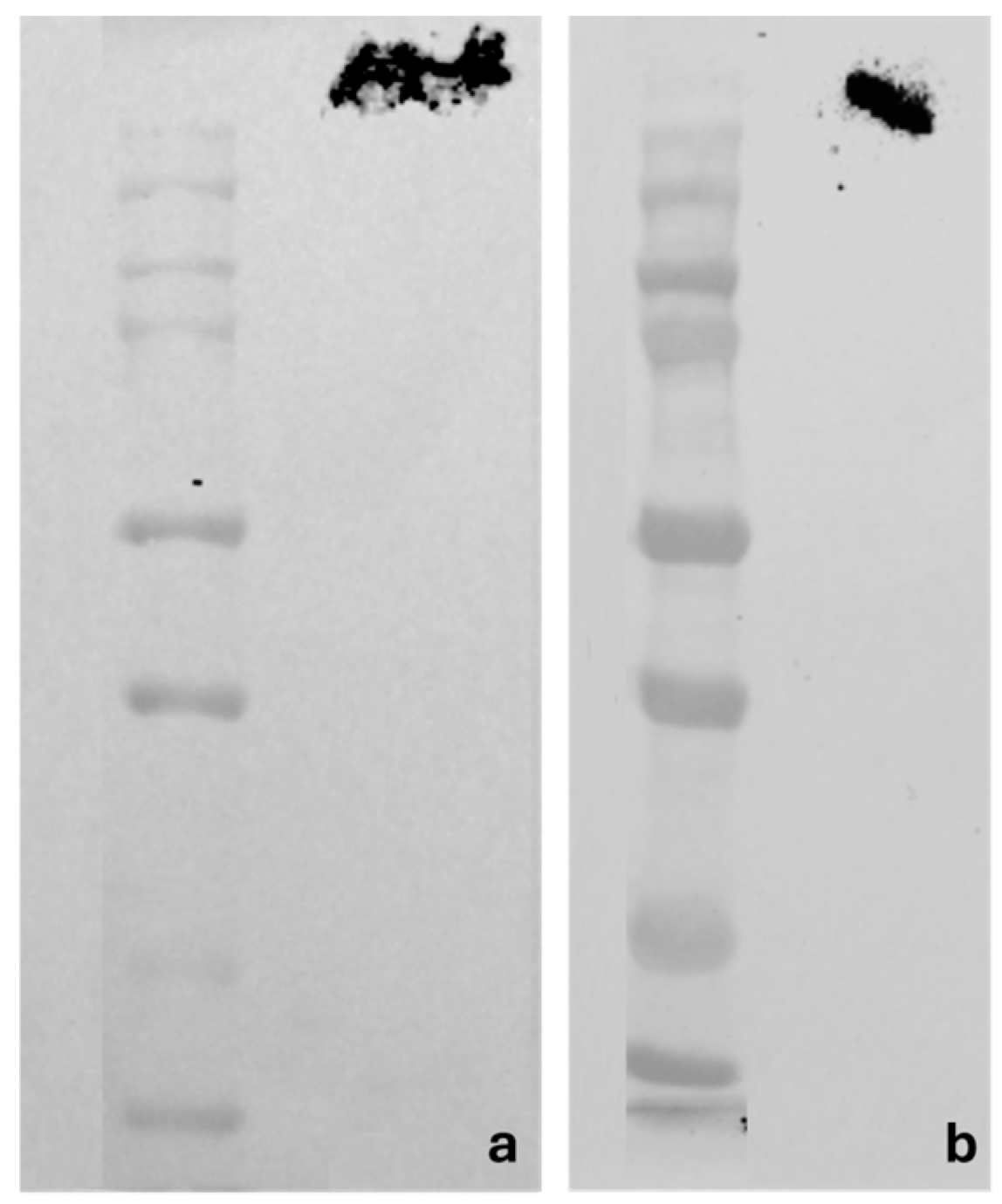
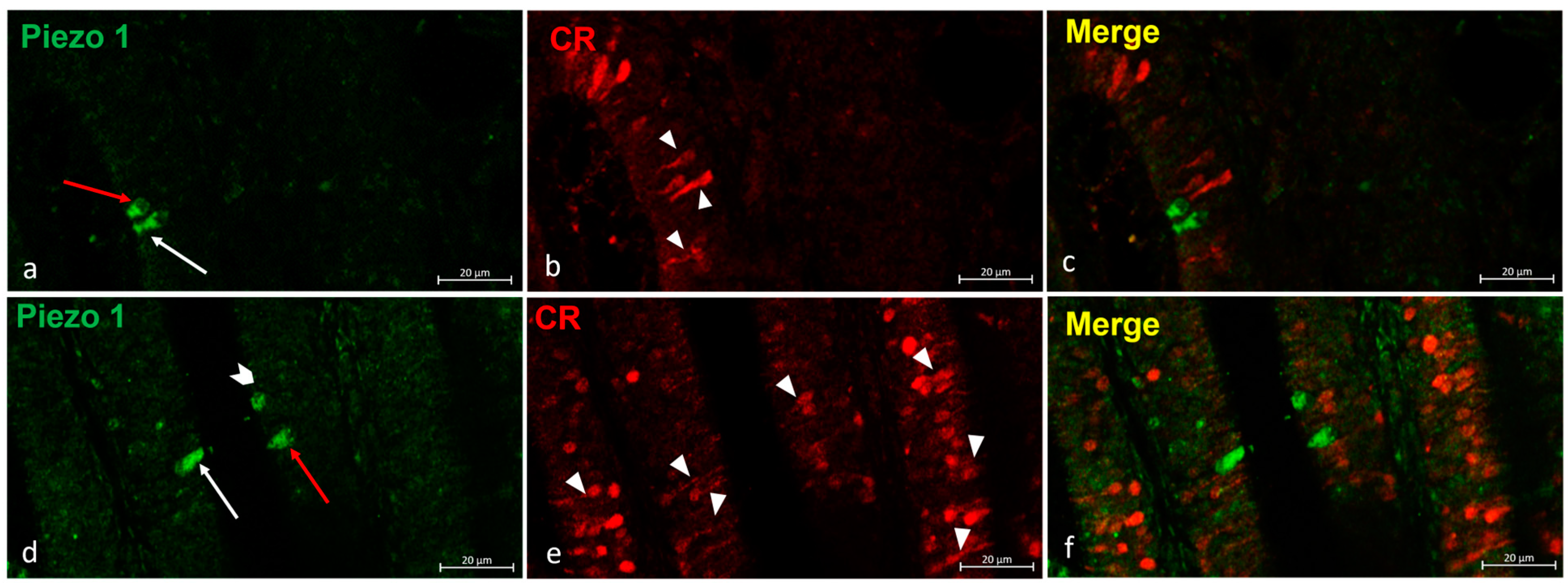
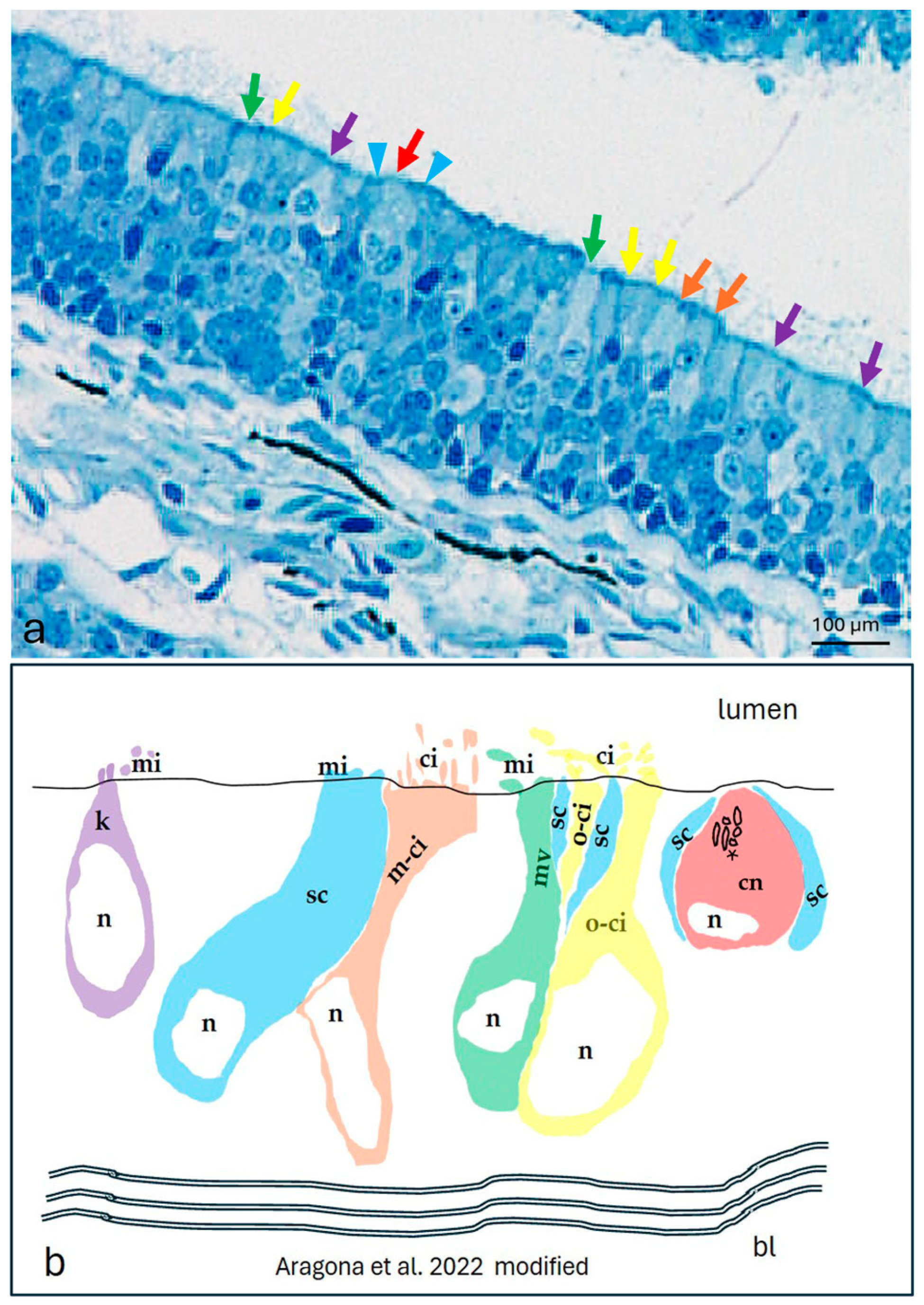

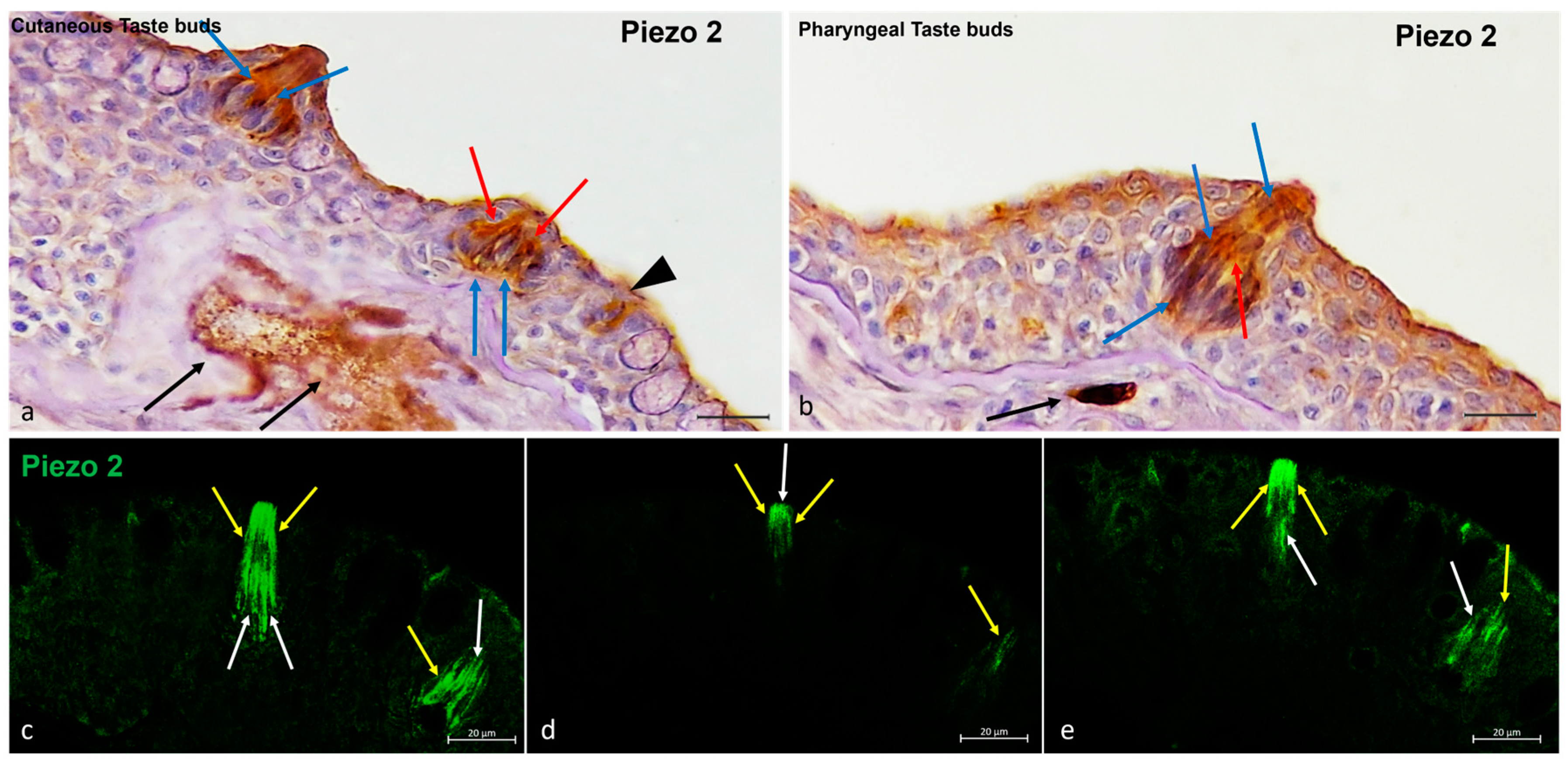
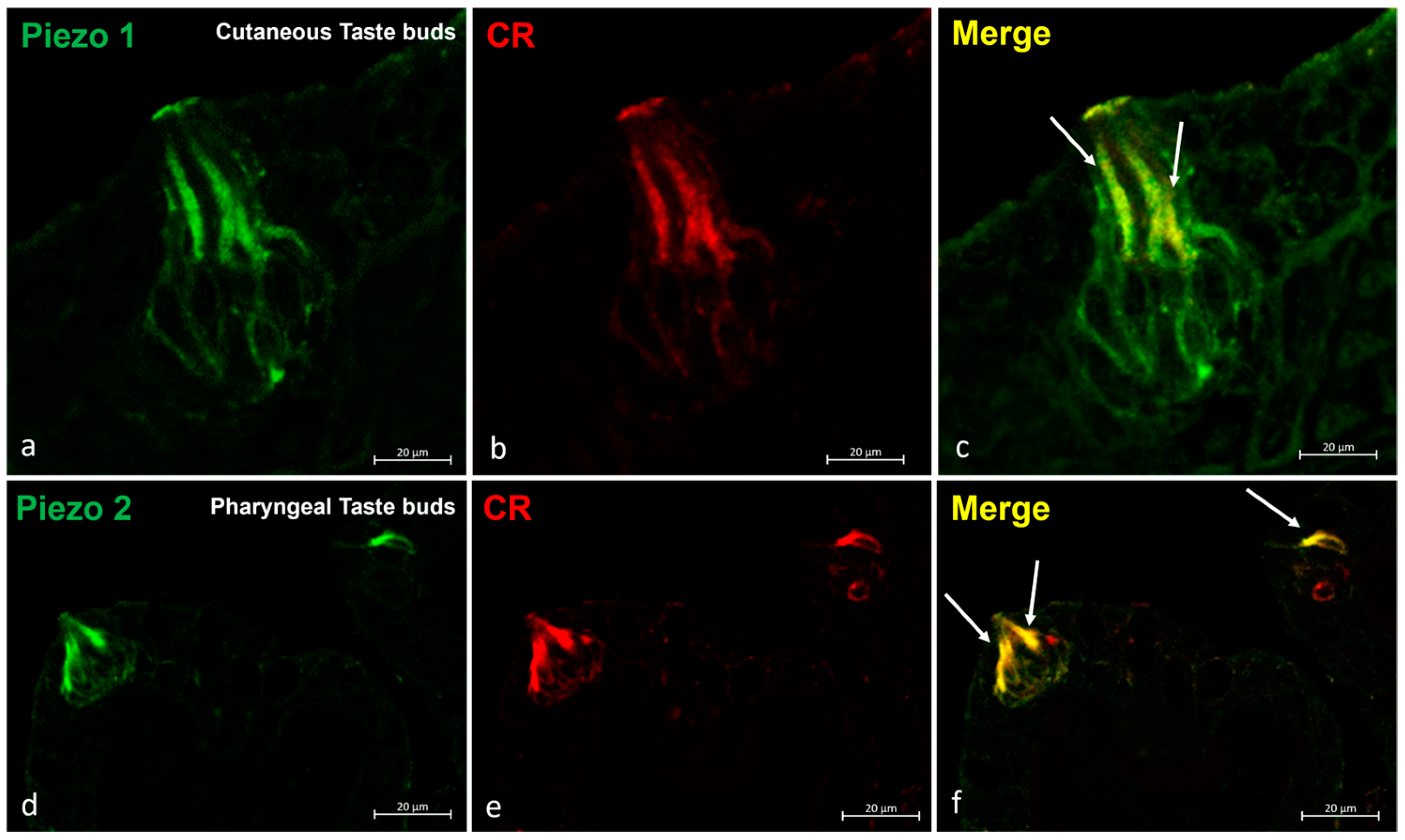
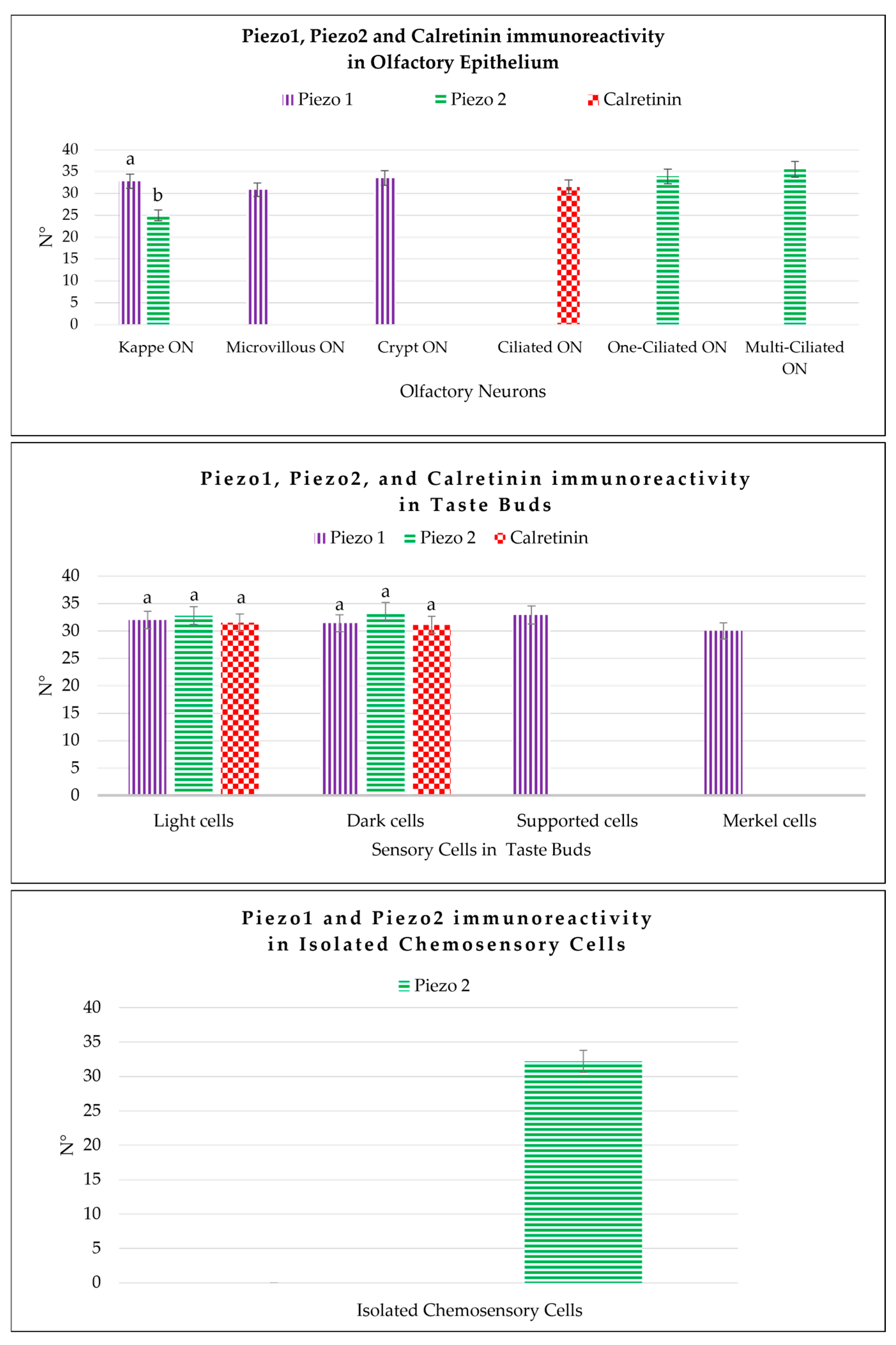
| Antibodies | Taxa’s Protein | Report of the Multiple Alignment | |||||||
|---|---|---|---|---|---|---|---|---|---|
| Product | Immunogen | Taxa | Query ID | Max Score | Total Score | Query Cover | E-Value | Per. Ident. | Acc. Len. |
| Piezo 1 Cat. # PA5-106296 | Human Piezo 1 (accession Q92508), corresponding to amino acid residues I642-L692 | Danio rerio | XP_696355.4 | 120 | 120 | 2% | 1 × 10−37 | 75.71% | 70 |
 | |||||||||
| Piezo 2 Cat. # PA5-72975 | Human Piezo 2 protein (between residues 1450 and 1500) [UniProt Q9H5I5] | Danio rerio | XP_021323952 | 93.6 | 93.6 | 1% | 4 × 10−28 | 83.02 | 53 |
 | |||||||||
| Calretinin (N-18) Cat. # sc-11644 | The specificity of the antibody has been previously demonstrated [10,40]. | ||||||||
| Mean ± ∆σ of Kappe ONs | Mean ± ∆σ of Ciliated ONs | Mean ± ∆σ of One-Ciliated ONs | Mean ± ∆σ of Multi-Ciliated ONs | Mean ± ∆σ of Microvillous ONs | Mean ± ∆σ of Crypt ONs | |
|---|---|---|---|---|---|---|
| Piezo 1 | 32.8 ± 4.6 | - | - | - | 30.8 ± 3.1 | 33.5 ± 4.9 |
| Piezo 2 | 25 ± 3.9 | - | 33.9 ± 3 | 35 ± 4.9 | - | - |
| Calretinin | - | 31.5 ± 4.5 | 33.5 ± 2.6 | 36 ± 8.7 | - | - |
| Mean ± ∆σ of Light Cells | Mean ± ∆σ of Dark Cells | Mean ± ∆σ of Supporting Cells | Mean ± ∆σ of Merkel-Like Cells | Mean ± ∆σ of ICCCs | |
|---|---|---|---|---|---|
| Piezo 1 | 32 ± 5.9 | 31.4 ± 4.7 | 32.9 ± 3.7 | 30 ± 6.8 | - |
| Piezo 2 | 28.4 ± 6 | 33.5 ± 3.8 | - | - | 32.2 ± 2.7 |
| Calretinin | 29.7 ± 3.9 | 31.1 ± 3.1 | - | - | - |
Disclaimer/Publisher’s Note: The statements, opinions and data contained in all publications are solely those of the individual author(s) and contributor(s) and not of MDPI and/or the editor(s). MDPI and/or the editor(s) disclaim responsibility for any injury to people or property resulting from any ideas, methods, instructions or products referred to in the content. |
© 2024 by the authors. Licensee MDPI, Basel, Switzerland. This article is an open access article distributed under the terms and conditions of the Creative Commons Attribution (CC BY) license (https://creativecommons.org/licenses/by/4.0/).
Share and Cite
Aragona, M.; Mhalhel, K.; Cometa, M.; Franco, G.A.; Montalbano, G.; Guerrera, M.C.; Levanti, M.; Laurà, R.; Abbate, F.; Vega, J.A.; et al. Piezo 1 and Piezo 2 in the Chemosensory Organs of Zebrafish (Danio rerio). Int. J. Mol. Sci. 2024, 25, 7404. https://doi.org/10.3390/ijms25137404
Aragona M, Mhalhel K, Cometa M, Franco GA, Montalbano G, Guerrera MC, Levanti M, Laurà R, Abbate F, Vega JA, et al. Piezo 1 and Piezo 2 in the Chemosensory Organs of Zebrafish (Danio rerio). International Journal of Molecular Sciences. 2024; 25(13):7404. https://doi.org/10.3390/ijms25137404
Chicago/Turabian StyleAragona, Marialuisa, Kamel Mhalhel, Marzio Cometa, Gianluca Antonio Franco, Giuseppe Montalbano, Maria Cristina Guerrera, Maria Levanti, Rosaria Laurà, Francesco Abbate, José A. Vega, and et al. 2024. "Piezo 1 and Piezo 2 in the Chemosensory Organs of Zebrafish (Danio rerio)" International Journal of Molecular Sciences 25, no. 13: 7404. https://doi.org/10.3390/ijms25137404






